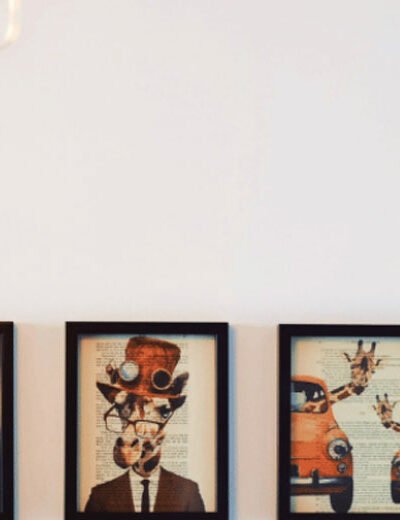Interior stylists are often tasked with transforming plain, impersonal spaces into visually captivating environments that spark emotion and reflect personality. While furniture and color palettes certainly play their part, there’s one element stylists consistently turn to for that final, transformative touch: wall art.
Wall art does more than fill a blank space. It creates narrative, adds depth, and, when chosen thoughtfully, evokes emotion in a way few other decorative elements can. As artist Chris DeRubeis once said, “All art should inspire and evoke emotion. Art should be something you can actually feel.” For many interior stylists, that feeling begins with canvas prints from The GOAT Wall Art.
The Rise of Statement Wall Art in Modern Interiors
Today’s interiors are more personalized than ever. From curated gallery walls to single oversized statement pieces, stylists are using art to define spaces. Canvas prints, in particular, offer a clean, polished look that’s versatile enough for modern, eclectic, or even rustic themes.
Unlike mass-produced posters or generic prints, canvas art offers depth, texture, and a sense of authenticity. It feels more intimate and deliberate, a key element for stylists aiming to create spaces that tell a story.
Why Interior Stylists Love Wall Art From The GOAT Wall Art
Stylists gravitate toward The GOAT Wall Art for several compelling reasons. Their collection blends quality, artistry, and functionality in a way that makes sense for both residential and commercial settings. Here’s what sets them apart:
- Unmatched Variety for Every Aesthetic: Whether you’re styling a tranquil beach-themed living room or an edgy urban loft, The GOAT Wall Art delivers. Their range includes animal portraits, space-inspired designs, typography, motivational quotes, black and white compositions, graffiti pieces, watercolor works, and a lot more. This wide selection allows stylists to source art that truly aligns with their vision, without feeling limited.
- Certified Quality That Lasts: Every canvas print is created using Greenguard ecologo-certified inks that are both environmentally friendly and fade-resistant. This ensures that each piece maintains its vibrancy and detail over time, even in spaces with ample natural light. The craftsmanship speaks volumes. These aren’t just prints; they’re investments in lasting beauty.
- Built to Endure Generations: The canvas prints are hand-stretched over premium pine stretcher bars, a detail that elevates the finished product significantly. This artisanal attention means each piece is designed to last over 100 years. It’s the kind of durability stylists appreciate when designing for longevity, especially in commercial settings like boutique hotels or upscale restaurants.
- Wholesale Options for Bigger Projects: Stylists working on large-scale projects appreciate the availability of wholesale pricing. Whether it’s outfitting an entire office building or furnishing multiple hotel rooms, The GOAT Wall Art accommodates bulk orders without compromising on quality.
- A Connection to Real Artists: One of the standout features of The GOAT Wall Art is its collaboration with real artists. This connection injects authenticity into every piece. As Edgar Degas once said, “Art is not what you see, but what you make others see.” This sentiment rings true in their catalog, where every canvas communicates something more than surface-level beauty.
About The GOAT Wall Art
The GOAT Wall Art was born out of a desire to offer more than just decorative pieces. At its core, the brand champions quality, detail, and connection. They don’t just produce wall art; they curate experiences.
The business started with a simple mission: to bridge the gap between accessibility and craftsmanship. Unlike mass-market print stores, The GOAT Wall Art prioritizes handmade frames, real canvas (never paper), and inks that meet high environmental standards.
The brand is also dedicated to customer satisfaction, with exceptional service being a core part of its ethos. Their team treats every order with care, whether it’s a single print for a studio apartment or a wholesale package for a hospitality project.
Wall Art in Commercial Spaces: A Growing Trend
Stylists aren’t the only ones catching on. Businesses, especially in the hospitality and wellness industries, are turning to canvas art to enhance ambiance. Hotels, spas, and co-working spaces are sourcing wall art not just as decor, but as brand statements. Art can instantly elevate the perception of a space, turning an ordinary lobby into an unforgettable first impression.
Canvas prints offer the kind of tactile richness and permanence that mass-produced posters simply can’t replicate. They convey intention and sophistication, qualities increasingly important in branding.
A Versatile Medium for Any Room
Canvas art is wonderfully adaptable. It works equally well above a headboard as it does in a minimalist office or cozy reading nook. This flexibility is part of what makes it a go-to choice for stylists.
Moreover, canvas has a warmth that glass-covered prints lack. It brings an almost tactile presence to a room, inviting closer inspection. And with such a broad range of designs available through The GOAT Wall Art, it’s easy to find a piece that aligns with the emotional tone a stylist is aiming for.
As Oscar Wilde famously said, “Art is the most intense mode of individualism that the world has known.” The GOAT Wall Art embraces this idea, offering prints that speak to a wide range of personal styles and sensibilities.
Conclusion
When it comes to creating spaces that resonate, inspire, and reflect personality, wall art is indispensable. For interior stylists, choosing the right source matters. The GOAT Wall Art stands out for its quality, artist partnerships, and dedication to craftsmanship that lasts generations.
Their extensive collection offers something for every aesthetic, making it easy for stylists to create rooms that tell stories, evoke feelings, and, above all, feel alive.
In a market crowded with forgettable decor, The GOAT Wall Art delivers pieces that make people stop, look, and feel, the ultimate goal of any great interior design.





Leave a Reply